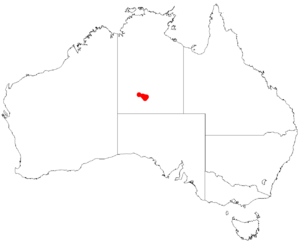Prostanthera schultzii facts for kids
Quick facts for kids Prostanthera schultzii |
|
|---|---|
| Conservation status | |
| Scientific classification | |
| Genus: |
Prostanthera
|
| Species: |
schultzii
|
 |
|
| Occurrence data from AVH | |
| Synonyms | |
|
Wrixonia schultzii (F.Muell. ex Tate) Carrick |
|
Prostanthera schultzii is a special kind of flowering plant. It is a shrub that grows only in the Northern Territory of Australia. This plant is part of the mint family, called Lamiaceae. It has interesting leaves that can be shaped like a heart, round, or like a paddle. Its beautiful white flowers have purple spots and yellow patches on the bottom part.
Contents
What Does It Look Like?
Prostanthera schultzii is a shrub that usually grows to be about 0.5 to 1.5 meters tall. That's like half the height of a grown-up to a bit taller than a grown-up. As the branches get older, they become stiff and can feel a bit like spines.
The leaves of this plant are quite unique. They can be shaped like a heart, be round, or look like a paddle. They are small, only about 4 to 12 millimeters long. Each leaf sits on a very short stem called a petiole.
The flowers grow in groups at the ends of the branches. They don't have their own little stems; they sit directly on the branch. The green parts under the petals, called sepals, form a tube about 3 to 3.5 millimeters long. This tube has two parts, or lobes.
The petals are white and have pretty purple spots. They also have yellow patches on their lower lip. The petals form a tube about 7 millimeters long. The lower lip of the petal tube has three parts, or lobes. The middle lobe is about 5 millimeters wide. The two side lobes are about 4 millimeters long and 3 millimeters wide.
The top part of the flower has two lobes. These are about 3 to 3.5 millimeters long and 2 to 2.5 millimeters wide. You can see this plant flowering in April and July. It also blooms from September to November.
How It Got Its Name
The plant Prostanthera schultzii was first officially described in 1896. A scientist named Ralph Tate wrote about it. He used notes from another scientist, Ferdinand von Mueller. Their description was published in a book about an expedition to Central Australia.
The first samples of the plant were collected on the high slopes of Mount Sonder. For a while, in 1976, a botanist named John Carrick changed its name to Wrixonia schultzii. But later, in 2012, three other scientists changed the name back to P. schultzii.
Where Does It Grow?
This special mintbush grows in the Northern Territory of Australia. You can find it on the sheltered upper slopes of the Chewings Range. This area is part of the beautiful West MacDonnell National Park.
Is It Safe? (Conservation Status)
Prostanthera schultzii is considered a "vulnerable" plant. This means it's at risk of becoming extinct if we don't protect it. The Australian Government has laws to protect it, like the Environment Protection and Biodiversity Conservation Act 1999. The Northern Territory Government also protects it under their Territory Parks and Wildlife Conservation Act 1976. These laws help make sure this unique plant can keep growing in Australia.


